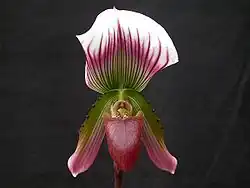Paphiopedilum callosum
| Paphiopedilum callosum | |
|---|---|

| |
| Flower of Paphiopedilum callosum | |
| Scientific classification | |
| Kingdom: | Plantae |
| Clade: | Tracheophytes |
| Clade: | Angiosperms |
| Clade: | Monocots |
| Order: | Asparagales |
| Family: | Orchidaceae |
| Subfamily: | Cypripedioideae |
| Genus: | Paphiopedilum |
| Species: | P. callosum
|
| Binomial name | |
| Paphiopedilum callosum | |
| Synonyms | |
| |
Paphiopedilum callosum is a species of slipper orchid found from Indochina to northern Peninsular Malaysia. Various hybrids forms are successfully cultivated, although its cultivation is considered to be difficult.[2][3] It has been investigated and shown promising results in the treatment of cancer.[4]
Taxonomy
P. callosum was originally described as Cypripedium callosum by Reichenbach in 1886, with the epithet was derived from Latin callosus, or "thick-skinned".[2] It was then reclassified into Paphiopedilum in Stein's Orchideenbuch in 1892, in a major reclassification of the then Cypripedium species into Paphiopedilum.[5] A few natural variants are recognized, including var. sublaeve, var. potentianum, var. viniferum, and fma. viridiforum.[2]
Description
P. callosum grows on deep leaf litter, and occasionally on mossy boulders. It consists of 3 to 5 leaves of 10–20 centimetres (3.9–7.9 in) long and 3–5 centimetres (1.2–2.0 in) wide, with its upper surface being mottled pale and dark green, while the under side is sometimes purple-suffused, and ciliate basal margins. Its purple, pubescent inflorescence measures 12–25 centimetres (4.7–9.8 in) in height, and consists of a single flower 8–11 centimetres (3.1–4.3 in). Peak flowering occurs from April to June.[2]
Distribution
P. callosum is available from the middle and southern part of Indochina to northern Malay Peninsula, in elevations of 300–1,300 metres (980–4,270 ft) and a mean temperature of 19–24 °C (66–75 °F), and grows along rivulets in closed forests over granite and sandstone.[2]
Biochemical profile
An extraction study in 2020 discovered a novel stilbenoid, which was identified as a topoisomerase I inhibitor, with varying degrees of cytotoxicity towards human cancer cell lines.[4]
References
- ^ Rankou, H.; Averyanov, L.; Svengsuksa, B. (2015). "Paphiopedilum callosum". IUCN Red List of Threatened Species. 2015: e.T191704A1999308. doi:10.2305/IUCN.UK.2015-2.RLTS.T191704A1999308.en. Retrieved 8 May 2022.
- ^ a b c d e Manza, Stephen (23 October 2006). "Paphiopedilum callosum". slipperorchids.info. Retrieved 24 July 2025.
- ^ "Paphiopedilum callosum Stein". World of Paphiopedilum. Retrieved 24 July 2025.
- ^ a b Nwe, San Yoon; Tungphatthong, Chayapol; Laorpaksa, Areerat; Sritularak, Boonchoo; Thanakijcharoenpath, Witchuda; Tanasupawat, Samboon; Sukrong, Suchada (2020). "Bioassay Guided Isolation of Topoisomerase Ι Poison from Paphiopedilum callosum (Rchb.f.) Stein". Records of Natural Products. 14 (2). ACG Publications: 89–97. doi:10.25135/rnp.144.19.06.1298. Retrieved 2 May 2022.
- ^ Stein, Berthold (1892). Stein's Orchideenbuch (in German). p. 457.
